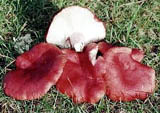 Russula
sanguinea
Russula
sanguinea Photos©CLCase
Fungi
Seen on Campus
Christine L. Case
 Russula
sanguinea Russula
sanguinea Photos©CLCase |
Fungi
Seen on Campus
|
About MushroomsMushrooms are the fruiting structure of fungi. The bulk of the fungus' body is underground as chains of cells (hyphae) called the mycelium. The hyphae absorb nutrients and generate energy for fungal growth. After sexual reproduction occurs between hyphae from opposite mating strains a mushroom forms to produce the reproductive spores. The spores are found in the gills or pores of the mushroom. Most mushrooms belong to the Phylum Basidiomycota. Click here to see a diagram. |
|||||
About edibility
|